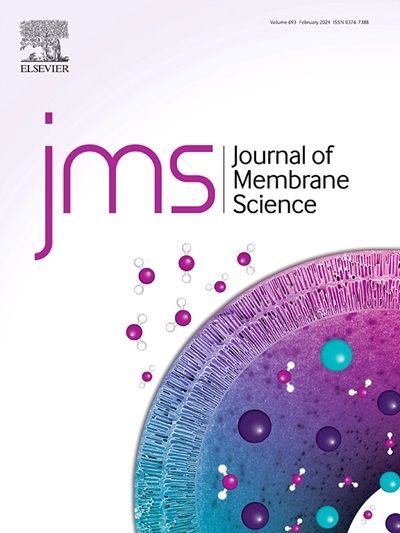Advancing organic solvent nanofiltration: Unveiling solvent-mediated reciprocal action with innovative polydimethylsiloxane composite membranes
IF 8.4
1区 工程技术
Q1 ENGINEERING, CHEMICAL
引用次数: 0
Abstract
Driven by the need for efficient organic solvent recovery, membrane-based organic solvent nanofiltration (OSN) technology has garnered significant attention for its cost-effectiveness and energy efficiency. Unlike aqueous filtration systems, the complex solvent environment in OSN processes leads to intricate solvent-mediated reciprocal actions among membranes, solvents and solutes, which, in turn, impact on the membrane performance, yet these effects remain unexplored. This study addressed this gap by systematically investigating these interactions and their effect on solvent permeation, solute distribution, and solvation-induced electrification, through the utilization of an innovative polydimethylsiloxane (PDMS) composite membrane. Our findings revealed that the solvent-mediated reciprocal actions result in different surface charge of the membrane in different solvents, leading to the solute rejection variation. Moreover, the discrepancy in the relative energy difference between the solvent and membrane contributed to variations in solvent permeance. The developed PDMS composite membrane achieved significantly enhanced solvent permeance and solute distribution, while its charged characteristics facilitated effective purification of charged contaminants beyond size exclusion limits. Remarkably, this PDMS composite membrane achieved ethyl acetate permeance up to eight times greater than current state-of-the-art polymeric OSN membranes, and demonstrated substantial dye rejection capabilities. This study offers fresh perspectives on optimizing OSN membrane performance for specific solvent-solute systems, highlighting its significance in advancing high-performance membrane technologies.

求助全文
约1分钟内获得全文
求助全文
来源期刊

Journal of Membrane Science
工程技术-高分子科学
CiteScore
17.10
自引率
17.90%
发文量
1031
审稿时长
2.5 months
期刊介绍:
The Journal of Membrane Science is a publication that focuses on membrane systems and is aimed at academic and industrial chemists, chemical engineers, materials scientists, and membranologists. It publishes original research and reviews on various aspects of membrane transport, membrane formation/structure, fouling, module/process design, and processes/applications. The journal primarily focuses on the structure, function, and performance of non-biological membranes but also includes papers that relate to biological membranes. The Journal of Membrane Science publishes Full Text Papers, State-of-the-Art Reviews, Letters to the Editor, and Perspectives.
 求助内容:
求助内容: 应助结果提醒方式:
应助结果提醒方式:


